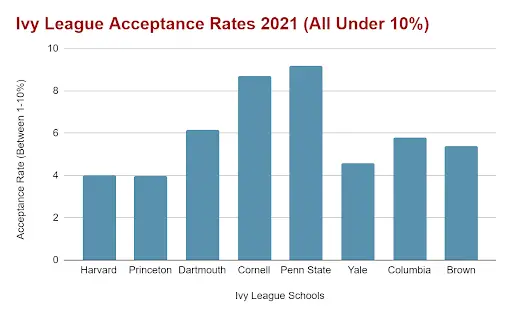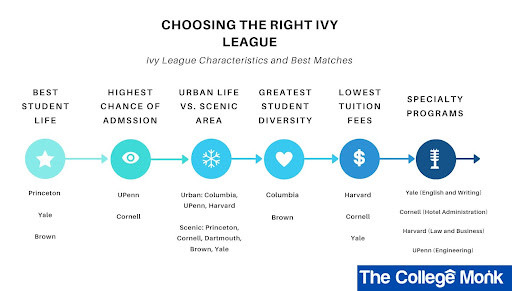Which Ivy League Should I Go To?
Thinking about Ivy League schools but wondering, “which Ivy League should I go to?” Read on to find out the differences between Ivy League schools.
Promising futures, unparalleled networking opportunities, and prestige come to mind when we think of Ivy League schools. Low acceptance rates and rigorous academic standards also come to mind, making Ivy League schools an impressive addition to any graduate’s resume.
You might be thinking: Out of the eight Ivy Leagues, which Ivy League should I go to? Each one makes its way to the top colleges in the US every year, making either of the eight great choices for college. However, they all share some differences to consider.
To help you narrow down which Ivy League school is right for you, we plan to compare Ivy League schools in this article and show you the differences between Ivy League schools.
First, let’s identify which US colleges are Ivy League.
Table of Contents
Which Ivy Leagues Are The Easiest And Hardest To Get Into
How to Figure Out Which Ivy League Is Best For Me
Which Schools Are Ivy League?
Here’s a list of the eight Ivy League schools:
- Harvard University
- Cornell University
- Yale University
- University of Pennsylvania
- Brown University
- Princeton University
- Columbia University
- Dartmouth College
Harvard University
Harvard University was established in 1636, making it the oldest of all the Ivy Leagues. While one of the most competitive schools in the world, Harvard also has the highest amount of money spent on each student through world-class faculty and facilities.
Harvard’s alumni lists boast many successful and famous personalities like John F. Kennedy, Bill Gates, and Mark Zuckerberg.
- Location: Cambridge, Massachusetts
- Undergrad Admitted: 2,320
- 2021 Acceptance Rate: 4%
- Popular Fields of Study: Harvard Business School, Harvard Medical School
- Graduation Rate: 96%
|
Pros and Cons of Harvard University |
|
|
Pros |
Cons |
|
Most extensive access to academic and professional resources |
Competitive admissions process, compared to other Ivy Leagues |
|
High graduation rate |
|
|
Impressive facilities, including its own museum of Scandinavian and Germanic art, observatory, and experimental forest |
|
|
Lower cost of attendance compared to other Ivy Leagues ($76,479) |
Brown University
Founded in 1764, Brown is famous for its open curriculum, an academic environment that doesn’t require core classes from students. This landscape allows students to explore their interests without fear of sacrificing their GPA, as they have the option to opt for Pass/Fail grades instead of numbered grades.
The school is known as one of the most progressive of the Ivy Leagues, as they’ve historically welcomed students from all races, genders, sexualities, and religions.
- Location: Providence, Rhode Island
- Undergrad Admitted: 2,537
- 2021 Acceptance Rate: 5.4%
- Popular Fields of Study:
- Graduation Rate: 95%
|
Pros and Cons of Brown University |
|
|
Pros |
Cons |
|
Experimental and exploratory academic culture, least competitive culture of all Ivy Leagues |
One of the highest costs of attendance, at $80,448 |
|
Progressive and inclusive environment |
Lack of urban lifestyle for students; one hour away from bigger city Boston |
|
High on lists of “Happiest Colleges” |
Columbia University
Columbia University is located in Manhattan, New York City, offering students quite the urban college experience. Its core courses are known for having a heavy focus on literature, even for science students.
Students with political hearts would love Columbia, as they’ve historically been known for student activism and political engagement.
- Location: New York, New York
- Undergrad Admitted: 2,185
- 2021 Acceptance Rate: 5.8%
- Popular Fields of Study:
- Graduation Rate: 95%
|
Pros and Cons of Columbia University |
|
|
Pros |
Cons |
|
Highest demographic of international and racially diverse students |
Higher cost of attendance than average for other Ivy Leagues ($80,339) |
|
Ideal learning environment for political science and political engagement, and student activism |
Yale University
Founded in 1701, Yale has a gorgeous campus with historic, Gothic architecture. If you’re a writer, Yale is the Ivy League for you, as it features over 100 writing courses and is famous for its stellar English literature program.
As one of the oldest Ivy Leagues, Yale has several old, longstanding associations, clubs, and “secret societies,” promoting a sense of community and closeness among its students and alumni.
- Location: New Haven, Connecticut
- Undergrad Admitted: 2,169
- 2021 Acceptance Rate: 4.6%
- Popular Fields of Study: English and creative arts
- Graduation Rate: 97%
|
Pros and Cons of Yale University |
|
|
Pros |
Cons |
|
Lower cost of attendance than average of other Ivy Leagues ($77,750) |
Stringent educational requirement for all undergraduate students to attend liberal arts college |
|
Pretty campus with Gothic architecture |
|
|
Highly ranked English program |
|
|
Tight-knit communities and “secret” societies |
|
|
Extremely high graduation rate |
Princeton University
Princeton is true to the Ivy League name since it hosts the most actual green ivy on campus than any other Ivy League college! Founded in 1746, Princeton is known for its excellence in research, boasting some of the greatest research programs, funding, and facilities in the country.
- Location: Princeton, New Jersey
- Undergrad Admitted: 1,890
- 2021 Acceptance Rate: 3.98%
- Popular Fields of Study:
- Graduation Rate: 98%
|
Pros and Cons of Princeton University |
|
|
Pros |
Cons |
|
Famous “eating clubs” and Greek community (sororities and fraternities) |
Highest cost of attendance out of all Ivy Leagues ($83,241) |
|
Extensive liberal arts education for all undergraduate students |
Dartmouth College
Dartmouth College was founded in 1769 and is ranked high among the world’s best educational institutions. If you’re a small-town kid at heart and you’re wondering, “which Ivy League school is the best for me,” then Dartmouth might be a good pick. Located in Hanover, students who prefer a calmer lifestyle will enjoy this small, scenic location for college. Dartmouth College is the only Ivy League school that uses a quarter system as opposed to the common semester system. In a quarter system, there are three grading periods instead of two within the school year.
- Location: Hanover, New Hampshire
- Undergrad Admitted: 1,749
- 2021 Acceptance Rate: 6.17%
- Popular Fields of Study: Economics, Political Science, Engineering
- Graduation Rate: 96%
|
Pros and Cons of Dartmouth College |
|
|
Pros |
Cons |
|
Small town with scenic views, great for outdoorsy students |
Higher cost of attendance than average for other Ivy Leagues ($79,525) |
|
Close-knit community due to smaller undergraduate population |
Small town limiting students who wish to have a more urban college experience |
|
Large “Greek” community (sororities and fraternities) |
Cornell University
Cornell University was founded in 1865 and offers one of the highest numbers of major and minor programs compared to the other Ivy Leagues. Their 80 major and over 1-- minors allow students to perfectly tailor their education to suit their interest to the most precise level. The college is also known for its agriculture program, as well as for its School of Hotel Administration.
- Location: Ithaca, New York
- Undergrad Admitted: 5,836
- 2021 Acceptance Rate: 8.7%
- Popular Fields of Study: Hotel administration, agriculture, business
- Graduation Rate: 95%
|
Pros and Cons of Cornell University |
|
|
Pros |
Cons |
|
Lower cost of attendance than average for other Ivy Leagues ($77,952) |
Less frequent opportunities for financial aid |
|
Pretty and scenic environment, located in Ithaca, New York |
University of Pennsylvania
Located in Philadelphia, UPenn offers students an urban lifestyle, brimming with internship and career opportunities close to campus. Founded in 1740, UPenn has a prestigious School of Nursing, a renowned school with programs unique from other Ivy Leagues.
- Location: Philadelphia, Pennsylvania
- Undergrad Admitted: 3,699
- 2021 Acceptance Rate: 9.2%
- Popular Fields of Study: Engineering, Business, Nursing
- Graduation Rate: 95%
|
Pros and Cons of University of Pennsylvania |
|
|
Pros |
Cons |
|
Great School of Nursing |
Higher cost of attendance than average for other Ivy Leagues ($79,635) |
|
Urban lifestyle, intertwined with the bustling city of Philadelphia |
Which Ivy Leagues Are The Easiest And The Hardest To Get Into?
Most Ivy League schools have notoriously low acceptance rates. These acceptance rates measure just how competitive the admissions processes are: in other words, how hard it is to get into a college. If you’re thinking, “which Ivy League should i apply to,” consider how difficult each one is to achieve acceptance.
Let’s take a look at each Ivy League school’s acceptance rate for 2021.

The chart above displays acceptance rates for each Ivy League in 2021, all falling between 1 and 10%. We can see that UPenn has the highest acceptance rate, at 9.2%. While 9.2% is a low acceptance rate when compared to other colleges, it’s high compared to other Ivy Leagues. Falling close behind is Cornell University, with an acceptance rate of 8.7%.
The lowest acceptance rates among the Ivy Leagues are for Princeton and Harvard, at 3.98% and 4%, respectively.
Given the above data, it’s fair to say that the easiest Ivy Leagues to get into are UPenn and Cornell, while the hardest Ivy Leagues to get into are Princeton and Harvard.
College Monk Ivy League Picks
You asked, so we answered! Check out our favorite Ivy League schools based on the following questions:
1. What Is the Prettiest Ivy League School?
This one was a close tie for us between Cornell University and Harvard University. Cornell has beautiful natural surroundings, complete with waterfalls, rolling hills, and a gorgeous view from most viewpoints within the buildings. The campus has many courtyards, giving the school a magical feel.
Harvard University impresses more with its historical buildings than its landscape. Its red-brick buildings feature Victorian-style architecture from the 18th century, making it a visual treat for any student in love with the classics!
2. Which Ivy League Has the Most Attractive Students?
First, we want to acknowledge that all Ivy League schools have attractive students! It’s quite difficult to pick just one. However, Business Insider came out with an article diving into Ivy League student attractiveness level based on data from Tinder, a dating app.
Tinder released stats on which students had the most “Yes,” swipes, which indicate for all intents and purposes, a high level of attractiveness. UPenn had the best-looking students.
3. Which Ivy League is Best for English?
English nerds need not look any further than Yale University for a stellar English program. Topping everyone’s lists for top English programs in the country, Yale boasts over 100 writing courses and an impressive Creative Arts program for readers and writers.
How to Figure Out Which Ivy League is Best For Me?
When deciding on an Ivy League, you should ask yourself a few key questions about the school’s location, competitiveness, facilities, and student life.
Take a look at the chart below to help you decide which Ivy League school is right for you.

Conclusion
If you’re wondering “which Ivy League should I go to,” think about all of your values and priorities for your education. Look at student life, tuition costs, location, and competitiveness. To compare Ivy League schools is to narrow down which one fits your needs best.
Interested in learning more about the Ivy Leagues? Check out our article about Ivy League Demographics.